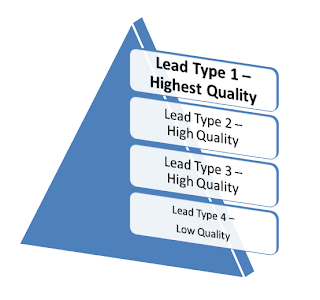"How do you measure lead quality?" inquired a Board member and a venture capitalist during a recent Board meeting. That question led to a very lively discussion that span from the approach to lead generation to the process of closing deals.
The
lead quality is a fundamental question that reflects the success of not just
demand generation, but the entire marketing engine and sales execution.
Lead Quality Success Metrics
One of the common demand generation mistakes is solely measuring the number of leads, regardless of their quality, conversion rates and timelines. This practice often leads into misalignment with sales teams, subjective reporting, conflicts, and lack of accountability for results.
Ultimately, the only thing that matters in terms of the lead quality is its conversion into a closed/won deal.
Ultimately, the only thing that matters in terms of the lead quality is its conversion into a closed/won deal.
However, with longer sales cycles, it can take months and years to measure and improve the lead quality if you solely rely on the ultimate success metric. So it is important to introduce micro-metrics that would monitor the lead quality at each conversion point and provide an opportunity to accurately predict whether it will turn into a deal and introduce process improvements as necessary.
Below
are some of the key variables for measuring the lead quality:
- Lead's
propensity to turn into a deal
- Time to
close the deal associated with that lead
- Revenue the
lead generates -- first year revenue and LCV (lifetime customer value)
- Cost of the
lead and cost of the deal it creates
While
the attributes above are paramount for measuring the quality of leads, there
are many other variables, such as the number of touches by sales people, sales
complexity associated with the deal, marketing resources associated with
generating the lead, ability to scale that particular type of a lead, etc.
Monitoring
Conversation Points
Monitoring
and measuring the lead quality at critical conversion points gives early
indications on lead quality issues. It also helps with identifying
potential process issues and execution challenges -- in demand generation,
sales/business development, and other marketing & sales areas.
The
funnel below is a typical one for companies in B2B space. The steps and
nomenclature may be different from company to company, however measuring
conversion rates between them is equally critical.
Let's
take a closer look at the key conversion points.
- Leads to MQL (marketing
qualified leads) or HQL (high-quality leads) conversion
rate helps to identify the percentage of leads that meet marketing
qualification criteria. This criteria is typically defined based on
ideal or desired customer profiles.
Once the lead scoring system is in place, demand generation team looks at the closed deals on an ongoing basis, analyzes them and updates the scoring system.
Lead scoring is usually automated via marketing tools or by using predictive scoring tools, such as with Infer, EverString, Lattice Engines and others.
- MQLs to SDR
(Sales Development Rep) Meetings and Opportunities conversion
percentages indicate how easy it is to get hold of the lead, conduct a
meaningful conversation, and schedule a meeting. SDR or BDR
conversations also provide invaluable qualitative feedback on the lead
quality in terms of the problem the prospect is trying to solve, timeline,
budgets, etc.
It is important for demand generation team members to speak with SDRs or BDRs daily to get feedback on the leads in order to apply incremental process improvements. There is also a growing trend of putting SDRs within Demand Generation teams in Marketing.
- SDR
Opportunities to Sales Meetings / Stages conversion
rate indicates how well SDRs have qualified their leads, documented
prospects' needs, collected data for sales reps and set the expectations
with prospects. Conversion rates at these stages are less indicative
of lead quality and more of the health of SDR organization and processes.
- Sales
Process Stages to Close conversion rates identify how leads are
moving through different stages of the sales process, where do they get
stuck, and how to expedite these leads through the pipleline. These
conversion rates also can pinpoint to the areas for sales process
improvements and changes.
- Inter-step
Conversion Metrics.
In order to build a well performing demand generation engine, it is
important to monitor not just conversion rates between adjacent steps, but
also measure the ones that skip steps, for example leads to
opportunities, MQLs to opportunities, leads to
deals, MQLs to deals, opportunity to deals,
and others depending on the particular sales model and funnel
type.
Salesforce.com and marketing automation tools, such as Marketo, Pardot from SFDC, Act-On, and others allow building dashboards and reports that make it easy to track these conversion rates.
- Conversion
Metrics by Attribution. Once you have figured out conversion
rates between various stages of demand generation and sales process, it is
really useful to break down these metrics and costs further by lead
acquisition channels.
Marketing automation tools typically provide basic functionality for this step, however you may want to use advanced attribution tools, like Bizible, to learn about different lead acquisition / influencing / converting channels and correlations between them.
Measuring
lead quality at its various inflection points helps with accurately assessing
the health of demand generation and sales processes. It enables companies
to objectively identify broken processes and fix them. It also provides a
clear idea to where invest marketing dollars to produce best yields and scale
the revenue while keeping costs down and sales efficiency high.
.





















.jpg)







